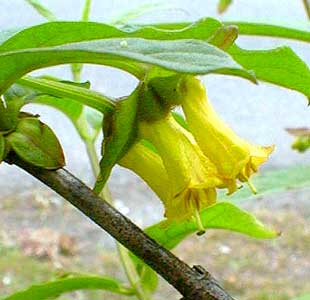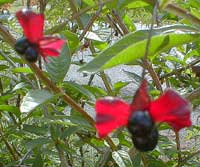
The Little Black Ratty
Memorial Twinberry
"Two lovely berries molded on one stem:
So, with two seeming bodies, but one heart."
-William Shakespeare
(1564-1616)
(1564-1616)
Little Black Ratty lived a long life by ratty standards. In his old age he became very feeble. Toward the end he lost his eyesight & became very clumsy getting around. His last week on earth, he had to be given water by hand, & would only eat very soft wet things. Then one morning he could barely move, having had a stroke during the night. Throughout his ordeal he still loved being held & petted & would struggle to get out of his hammock to be picked up whenever he heard us at the cage door.
Very tame rats become ultra sweet when they are in need. The fact that they become increasingly trusting & endearing instead of crabby or mean as their health falls away from them makes the final passage of a pet rat all the more grief-causing. Little Black Ratty died that last morning in Granny Artemis's arms, with kisses & the sounds of loving cooings his last earthly experiences.
 I was about to plant a Black Twinberry (Lonicera involucrata var involucrata) in a sunny roadside garden near a Serviceberry shrub & a "Jean Marie" rhododendron, so I dug the hole extra deep & laid Little Black Ratty well below the bottom roots of the twinberry, so that it is forever to be the Little Black Ratty Memorial Twinberry.
I was about to plant a Black Twinberry (Lonicera involucrata var involucrata) in a sunny roadside garden near a Serviceberry shrub & a "Jean Marie" rhododendron, so I dug the hole extra deep & laid Little Black Ratty well below the bottom roots of the twinberry, so that it is forever to be the Little Black Ratty Memorial Twinberry.Black Twinberry is also known as Inkberry for the fruits' color, & as Bracted Honeysuckle because of the showy bracts that appear with the fruit. It is called Bearberry Honeysuckle or most whimsically "Grizzly Berries" because guess who likes to eat the fruit. The name Fly Honeysuckle is shared with several other woody honeysuckles with twin flowers. I'm guessing these have become so-named "Fly" because they are pollinated in some places by bee-flies attracted to the famed nectar of the genus. The alternate name Four-line Honeysuckle puzzles me because I cannot perceive lines on the flowers, leaves, stems, or anything, though some very fresh young stems start out square.
Twinberry is a woody, branching honeysuckle shrub, semi-evergreen to fully deciduous. Young branches have yellow bark, which ages to yellow-brown. Sixteen-foot specimens are occasionally encountered in the wild, spreading into thickets which occur from mountain to subalpine elevations. Generally it does not exceed ten feet tall, & in gardens usually no more than eight feet. When pruned to keep it more compact, one can keep it restrained to the six-foot range without interfering with its natural beauty.
It thrives in a wide range of soils, tolerates a wide range of temperatures, likes full sun or part shade. The further south it grows, the higher in mountains it prefers to be, as it can be heat sensitive. Although it can be drought tolerant if emergency is it needs to be in order to survive harsh conditions, in the wild it is often seen growing near water or in wetlands, & as a gardened shrub will always flower & fruit vastly better with regular watering in an unstressful position with lots of sun.
Large ovate pointed leaves are a rich bright green, & the upright stance of the shrub makes it a tad formal. The shrub's bee, butterfly, & hummingbird-attracting dangling yellow trumpet-flowers occur mostly in pairs. At only a half-inch length, these blooms are small compared to the leaves, hence not nearly as showy as are flowers for vining honeysuckles. They are nevertheless awfully pretty on close inspection.
Blooms can appear in late spring -- ours is blooming wonderfully by the end of March -- but especially in summer, peaking in June & July, with a few more flowers all the way into autumn. Because the blooms occur serially, it will still be producing flowers after berries begin.
As I look down from a second floor window in late March & early April, I can see the serviceberry's pre-leafing white flowers very showy from a distance, but the lovely wee yellow blooms of the twinberry are not visible from afar. They are close-up experiences only.
But later in the year the shrub will put on an amazing display of fruit. Already by mid-April berries can be seen starting to develop in pairs. By early June ripe berries are on display. When they mature, bright red bracts surround purple-black to jet-black doubled fruit. That the fruit occurs mainly in pairs is a wonderful little oddity in itself: two quarter-inch berries create considerable drama with their combined half-inch width framed in flowery-red bracts. These are far showier than the pretty little yellow flowers, & the bracted fruits persist for a long time on the shrub, being not all ripening at the same time. (See also the Twinberry Page of the Berries Gallery.
Native to the entire west coast of North America from Alaska to Mexico, there are additional sporadic populations in the Great Lakes region of Canada & the US. The berries are edible but apparently vary in flavorfulness throughout its extensive range, as some report it being too bitter to be widely eaten, while others insist that it is pleasant tasting. Reports of its toxicity are at best exaggerated.
Though overlooked by modern herbalists, it was formerly an important medicinal plant to native coastal peoples. An eyewash was made from the juice of the berries, as longhouse dwellers commonly had eye irration due to living in smoky lodges. When the berries were not in season, then the shreddy bark or the leaves would be boiled for an eyewash. The fruits were also used as a soap to fight dandruff, & as a hair-dye to hide grey.
The leaves, softened by boiling, were used as dressings for itch, burns, wounds, & as a poltice for venereal scabs. Berries, bark, & leaves were used in tonics for cough, or applied to breasts in the belief that it would induce better milk flow.
Whether any of these values could be sustained by doubleblind studies to test efficacy is unknown because it has not been tested.